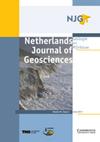Induced seismicity in the Groningen gas field – arrest of ruptures by fault plane irregularities
IF 2.3
2区 地球科学
Q3 GEOSCIENCES, MULTIDISCIPLINARY
Netherlands Journal of Geosciences-Geologie En Mijnbouw
Pub Date : 2023-01-01
DOI:10.1017/njg.2023.9
引用次数: 0
Abstract
Abstract From dynamic rupture simulations, we reveal under which conditions a rupture in the Groningen gas field stops along fault dip or along fault strike after it starts on a fault in the reservoir. The simulations focus on the capabilities of fault plane irregularities to arrest ruptures. Such irregularities can be recognised in sandstone outcrops. Fault planes in the Groningen field, extracted from the 3D seismic data by seismic attribute extraction methods, show similar irregularities. A detailed surface of a major fault plane in the field indicates that steps and jogs of tenths of metres are possible. Although these irregularities are close to seismic resolution and could be partially artificial, we investigated their effect on rupture arrest. For typical current stresses in the Groningen field, jogs and steps of this length scale are found to be remarkably effective to stop ruptures in the reservoir. Also, a significant increase in the fault dip along fault strike can stop these ruptures but a kink in the fault under a constant fault dip not. Including non-planar fault features and pressure diffusion in the Carboniferous, the simulations in this paper follow trends of previous simulations in the literature using 2D planar faults. In particular, the horizontal stress in this formation and the strength of the Carboniferous fault zone are important for rupture propagation. If the fault would have been reactivated in the Neogene or Quaternary and poorly healed in clay-rich parts, rupture propagation into the Carboniferous can only be prevented by jogs of sufficient size and lateral continuity under the present estimate of the horizontal field stress.格罗宁根气田的诱发地震活动性——断平面不规则性对破裂的抑制
通过动态破裂模拟,揭示了格罗宁根气田的破裂在油藏断层上开始后沿断层倾向或沿断层走向停止的条件。模拟的重点是断层平面不规则性阻止破裂的能力。这种不规则性可以在砂岩露头中识别出来。利用地震属性提取方法从三维地震数据中提取出的Groningen油田断平面也表现出类似的不规则性。野外一个主要断裂面的详细表面表明,有可能出现十分之一米的台阶和慢跑。尽管这些不规则现象接近地震分辨率,而且可能部分是人为的,但我们研究了它们对阻止破裂的影响。对于格罗宁根油田的典型电流应力,发现这种长度尺度的缓动和台阶对于阻止储层破裂非常有效。此外,沿断层走向显著增加断层倾角可以阻止这些破裂,但在断层倾角恒定的情况下,断层的扭结不能阻止这些破裂。考虑到石炭系非平面断层特征和压力扩散,本文的模拟延续了以往二维平面断层模拟的趋势。特别是该地层的水平应力和石炭系断裂带的强度对破裂扩展具有重要意义。如果断层在新近纪或第四纪被重新激活,并且在富含粘土的部分愈合不良,那么在目前估计的水平应力场下,只有通过足够大小的滑动和横向连续性才能阻止断裂扩展到石炭系。
本文章由计算机程序翻译,如有差异,请以英文原文为准。
求助全文
约1分钟内获得全文
求助全文
来源期刊
CiteScore
4.00
自引率
25.90%
发文量
14
审稿时长
>12 weeks
期刊介绍:
Netherlands Journal of Geosciences - Geologie en Mijnbouw is a fully open access journal which publishes papers on all aspects of geoscience, providing they are of international interest and quality. As the official publication of the ''Netherlands Journal of Geosciences'' Foundation the journal publishes new and significant research in geosciences with a regional focus on the Netherlands, the North Sea region and relevant adjacent areas. A wide range of topics within the geosciences are covered in the journal, including "geology, physical geography, geophyics, (geo-)archeology, paleontology, hydro(geo)logy, hydrocarbon exploration, modelling and visualisation."
The journal is a continuation of Geologie and Mijnbouw (published by the Royal Geological and Mining Society of the Netherlands, KNGMG) and Mededelingen Nederlands Instituut voor Toegepaste Geowetenschappen (published by TNO Geological Survey of the Netherlands). The journal is published in full colour.

 求助内容:
求助内容: 应助结果提醒方式:
应助结果提醒方式:


